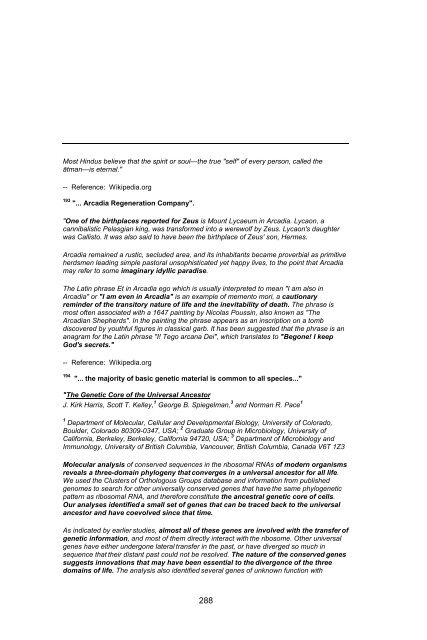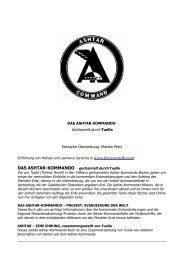- Page 1 and 2:
ALIEN INTERVIEW Based On Personal N
- Page 3 and 4:
Acknowledgements My sincerest thank
- Page 5 and 6:
Foreword: "We ask, as Fools who kno
- Page 7 and 8:
Dedication This book is dedicated t
- Page 9 and 10:
Vested Interest: Definitions a surv
- Page 11 and 12:
In addition, the subject has become
- Page 13 and 14:
About The Source Of Material In Thi
- Page 15 and 16:
In short, scientists suffer from th
- Page 17 and 18:
was suspected of having been involv
- Page 19 and 20:
The Letter from Mrs. MacElroy _____
- Page 21 and 22:
historic times. In ancient Irish re
- Page 23 and 24:
alloon. The true facts of the incid
- Page 25 and 26:
Our communication did not consist o
- Page 27 and 28:
Chapter One My First Interview With
- Page 29 and 30:
and camera equipment. A motion pict
- Page 31 and 32:
IT WAS STRUCK BY AN ELECTRICAL DISC
- Page 33 and 34:
QUESTION - "Have your people visite
- Page 35 and 36:
"This was the conclusion of the fir
- Page 37 and 38:
controlling my interviews. I had no
- Page 39 and 40:
little time with each other. I was
- Page 41 and 42:
QUESTION - How can we make them und
- Page 43 and 44:
I admitted that I couldn't really u
- Page 45 and 46:
Chapter Five Reading Lessons (MATIL
- Page 47 and 48:
43 (Footnote), "Don Quixote de la M
- Page 49 and 50:
(OFFICIAL TRANSCRIPT OF INTERVIEW)
- Page 51 and 52:
(MATILDA O'DONNELL MACELROY PERSONA
- Page 53 and 54:
When the lightning bolt struck the
- Page 55 and 56:
Chapter Seven A Lesson In Ancient H
- Page 57 and 58:
Airl explained that IS-BEs have bee
- Page 59 and 60:
carbon-based matter, that there is
- Page 61 and 62:
sent other crews to Earth to look f
- Page 63 and 64:
a "prison planet" for a very long t
- Page 65 and 66:
This, in part, explains the very un
- Page 67 and 68:
major and fundamental scientific an
- Page 69 and 70:
Consequently, the population of Ear
- Page 71 and 72:
A "Sun Type 12, Class 7" planet is
- Page 73 and 74:
prophets, such as the Jewish slave
- Page 75 and 76:
In addition, Earth, inherently, is
- Page 77 and 78:
3) take over of natural resources b
- Page 79 and 80:
Therefore, as a matter of common lo
- Page 81 and 82:
investigator, no matter how brillia
- Page 83 and 84:
Apparently, the volcanic eruption e
- Page 85 and 86:
create the illusion of eternity. De
- Page 87 and 88:
part of a false spirituality based
- Page 89 and 90:
8,050 BCE -- Destruction of the "Ol
- Page 91 and 92:
the Egyptians. Their symbol was the
- Page 93 and 94:
the first succession of 10 human Ph
- Page 95 and 96:
The configuration of all the pyrami
- Page 97 and 98:
"Old Empire" high-priests, Psenophi
- Page 99 and 100:
IS-BEs who inhabit them will recycl
- Page 101 and 102:
tool designed to detect the presenc
- Page 103 and 104:
configuration of the Giza pyramids
- Page 105 and 106:
control over the inmate population.
- Page 107 and 108:
(OFFICIAL TRANSCRIPT OF INTERVIEW)
- Page 109 and 110:
The reason is simple: the idea that
- Page 111 and 112:
A computer is an electronic device
- Page 113 and 114:
without manipulation of genetic mat
- Page 115 and 116:
'solution', "Bugs & Blossoms" propo
- Page 117 and 118:
As I mentioned, there is a very hig
- Page 119 and 120:
emorseful about having injured this
- Page 121 and 122:
Chapter Eleven A Lesson In Science
- Page 123 and 124:
answer is simple: the influence of
- Page 125 and 126:
een prohibited by science which eli
- Page 127 and 128:
Some features will be indecipherabl
- Page 129 and 130:
Chapter Twelve A Lesson In Immortal
- Page 131 and 132:
In this fashion, all of the space,
- Page 133 and 134:
Chapter Thirteen A Lesson In The Fu
- Page 135 and 136:
(EDITOR'S NOTE: At this point, the
- Page 137 and 138:
About six hours before the Japanese
- Page 139 and 140:
Chapter Fourteen Airl Reviews The I
- Page 141 and 142:
"May I ask why not?", I said. I was
- Page 143 and 144:
Dr. Wilcox told me that they would
- Page 145 and 146:
Mr. Reid explained to me that, in r
- Page 147 and 148:
MPs, with their assistance this tim
- Page 149 and 150:
The following day I received writte
- Page 151 and 152:
this point I am still not able to f
- Page 153 and 154:
Bessemer 247 (Footnote) who lived i
- Page 155 and 156:
Good Luck To All Of Us, Matilda O'D
- Page 157 and 158:
Literature for Immortal Spiritual B
- Page 159 and 160:
"Majestic 12" or "MJ-12". (NOTE: Al
- Page 161 and 162:
-- Reference: Wikipedia.org 6 "...T
- Page 163 and 164:
chose to strike the word congressio
- Page 165 and 166:
was also told by others about the s
- Page 167 and 168:
B-29 that took Major Marcel to Fort
- Page 169 and 170:
"The Flight Nurse Badge is issued i
- Page 171 and 172:
19 "...I discovered that one of the
- Page 173 and 174:
hasn't seen anything at the base."
- Page 175 and 176:
-- Reference: Wikipedia.org 23 "...
- Page 177 and 178:
where: • F is the magnitude of th
- Page 179 and 180:
Reflected in much of her research i
- Page 181 and 182:
38 "... the Japanese people have a
- Page 183 and 184:
sound /k/ can be represented by c,
- Page 185 and 186:
in the middle of an exposition of a
- Page 187 and 188:
Vedic Sanskrit is the earliest atte
- Page 189 and 190:
Pushpaka was originally made by May
- Page 191 and 192:
The imagined future of space opera
- Page 193 and 194:
According to hitherto unconfirmed r
- Page 195 and 196:
“NASA scientists and engineers pa
- Page 197 and 198:
gypsum by groundwater in near surfa
- Page 199 and 200:
63 "...points of origin to establis
- Page 201 and 202:
eversals of fortune, as when Seneca
- Page 203 and 204:
Examples of force fields: • A loc
- Page 205 and 206:
Examples: Any number, color, object
- Page 207 and 208:
Editor's Note: The only Wikipedia.o
- Page 209 and 210:
• Control the victim's social and
- Page 211 and 212:
80 "... remote thought control..."
- Page 213 and 214:
tests on unwitting citizens 'at all
- Page 215 and 216:
Budget A secretive arrangement gran
- Page 217 and 218:
cognizant human subjects as part of
- Page 219 and 220:
The scientific revolution is consid
- Page 221 and 222:
memories. However, it should be not
- Page 223 and 224:
Other theories which are not depend
- Page 225 and 226:
Egalitarian, (derived from the Fren
- Page 227 and 228:
ecollections, and what he reads in
- Page 229 and 230:
Upon that desire arose in the begin
- Page 231 and 232:
Henry Ford was convinced he had liv
- Page 233 and 234:
His religious reformation appears t
- Page 235 and 236:
introduced by his predecessor Akenh
- Page 237 and 238: Aramaic language of their Babylonia
- Page 239 and 240: In Zoroastrianism, good transpires
- Page 241 and 242: suppress political opposition and d
- Page 243 and 244: -- Reference: Wikipedia.org 121 ...
- Page 245 and 246: "The tragedy is that the PSYCHIATRI
- Page 247 and 248: -- Reference: Wikipedia.org 126 "..
- Page 249 and 250: -- Reference: Wikipedia.org 129 "..
- Page 251 and 252: -- Reference: Article: Terminal Cre
- Page 253 and 254: Albert Einstein. The Einstein-Hapgo
- Page 255 and 256: themselves. The Nephilim attacked a
- Page 257 and 258: could easily accommodate all the li
- Page 259 and 260: water doesn't boil. Water at a dept
- Page 261 and 262: "The temple of Pachacamac is an arc
- Page 263 and 264: eing inscribed in the pyramids but
- Page 265 and 266: -- Reference: Wikipedia.org 157 "..
- Page 267 and 268: Exhaustive Concordance), where it i
- Page 269 and 270: The name Zoroaster was famous in cl
- Page 271 and 272: 2 that the "sons of God" saw that t
- Page 273 and 274: “Cyrus the Great is genuinely one
- Page 275 and 276: propagated by the fact that after t
- Page 277 and 278: meaning something to the effect of
- Page 279 and 280: "When these young men woke, and fou
- Page 281 and 282: "Banking in Switzerland is characte
- Page 283 and 284: • Harold D. Pennington - 1 share
- Page 285 and 286: Nazi War Finance and Banking Our Ec
- Page 287: 191 "...Grimm's Fairy Tales..." "Th
- Page 291 and 292: 'I look at the term species as one
- Page 293 and 294: -- Reference: Wikipedia.org 202 "..
- Page 295 and 296: A mating dance may be used as an ex
- Page 297 and 298: One megalight-year, abbreviated "Ml
- Page 299 and 300: Carver's most important accomplishm
- Page 301 and 302: Kubrick film from 1964, Dr. Strange
- Page 303 and 304: The single strangest invention Tesl
- Page 305 and 306: According to Corso, the reverse eng
- Page 307 and 308: they will contain IC s in fabric to
- Page 309 and 310: 228 "... just before the Japanese a
- Page 311 and 312: Lieutenant General Vandenberg was d
- Page 313 and 314: Electroencephalography (EEG) is the
- Page 315 and 316: 241 "... Suleiman the Magnificent..
- Page 317 and 318: -- Reference: Wikipedia.org 244 "..
- Page 319:
According to Gray's account, his pa





